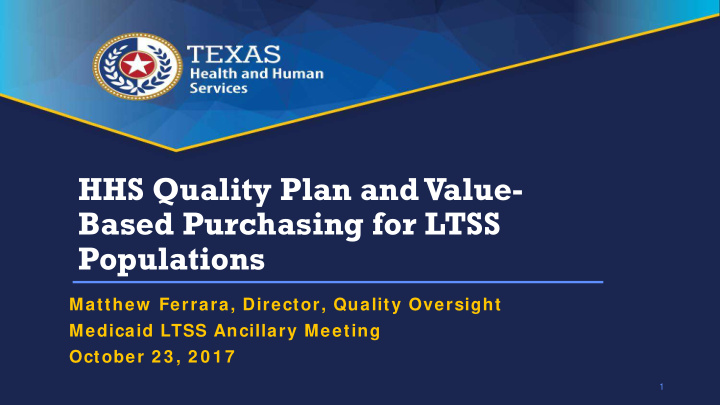



HHS Quality Plan and Value- Based Purchasing for LTSS Populations Matthew Ferrara, Director, Quality Oversight Medicaid LTSS Ancillary Meeting October 2 3 , 2 0 1 7 1
Healthcare Quality Plan Establishes six priorities: 1 . Keeping Texans healthy Through prevention and by engaging individuals, families, communities, and the healthcare system to address root causes of poor health 2 . Providing the right care in the right place To ensure that people receive timely services in the least intensive or restrictive setting 3 . Keeping patients free from harm By building a safer healthcare system that limits human error 4 . Prom oting effective practices for chronic disease To better manage this leading driver of healthcare costs 5 . Supporting patients and fam ilies facing serious illness To meet physical, emotional, and other needs 6 . Attracting high perform ing professionals For team based, collaborative, and coordinated care
Healthcare Quality Plan Highlights seven quality im provem ent tools: 1. Contracting for Value 2. Aligning Payments with Value 3. Empowering Individuals 4. Simplifying Administrative Processes 5. Leveraging Business Intelligence 6. Increasing Health Information Technology and Exchange 7. Expanding Public Reporting
Healthcare Quality Plan Calls for a dashboard to m easure progress: • Metrics will be small in number; high impact; indicative of value, not just quality or cost; and broadly focused • Metrics reported statewide and by regional healthcare partnership regions and managed care service areas • Dashboard updated regularly to inform Quality Plan revisions and program level operational planning • Where appropriate, metrics stratified by key population groups
Healthcare Quality Plan Potential dashboard population stratifications include: • Newborns and children • Pregnant women and mothers • Individuals with mental health and or substance use disorders • Individuals with complex health care needs (e.g., multiple chronic conditions or co-occurring conditions) • Individuals age 65 and over • Individuals eligible for long term services and supports
Value-Based Purchasing Roadmap Value-Based Purchasing Roadm ap-Guiding Principles: • Continuous Engagement of Stakeholders • Harmonize Efforts • Administrative Simplification • Data Driven Decision-Making • Movement through the VBP Continuum • Reward Success 6
Core Value-Based Purchasing (VBP) Programs • Managed Care Organization Pay for Quality • Dental Maintenance Organization Pay for Quality • Hospital Pay for Quality • MCO payment reform (VBP) effort with providers • Delivery System Reform Incentive Payment (DSRIP) Program • Quality Incentive Payment Program (QIPP) 7
• Managed Care Organization Pay for Quality-LTSS • 3% of MCO Premiums at Risk • Competitive, redistributive model, focused on improvement • If a STAR+ PLUS MCO performance decreases beyond a certain threshold amount overall on a P4Q measure, HHSC will recoup from the premiums at risk for that measure • Other STAR+ PLUS MCOs could earn recouped money if performance improves beyond a threshold amount • Bonus Pool • At Risk Measures for LTSS Populations: • Potentially Preventable ED Visits • Diabetes Control - HbA1c < 8% (CDC) • High blood pressure controlled (CBP) • Diabetes Screening for People with Schizophrenia or Bipolar Disorder who are using antipsychotics (SSD) • Cervical cancer screening (CCS) 8
• Managed Care Organization Pay for Quality-LTSS • Bonus Pool Measures for LTSS Populations: • Good access to urgent care • Potentially preventable readmissions • Potentially preventable complications • Prevention Quality Indicator Composite 9
• MCO payment reform (VBP) effort with providers -LTSS • Contractual targets for VBP • CY2018: • 25% Overall, increasing to 50% in 2021 • 10% risk based, increasing to 25% in 2021 • Other contract requirements • MCO flexibility to target their “opportunity areas” with providers • MCOs tend to push down P4Q measures in their VBP contracts with providers • Most VBP models are FFS based with upside incentives. 10
• Quality Incentive Payment Program (QIPP) • Additional payments to nursing facilities based upon improvements in quality and innovation in the provision of nursing facility services • Includes payment incentives to improve the quality of care for their residents. Facilities will be able to achieve this goal by showing an improvement over baselines as they relate to each of the four quality measures: • High-risk residents with pressure ulcers; • Percent of residents who received an antipsychotic medication (long-stay); • Residents experiencing one or more falls with major injury; and • Residents who were physically restrained. 11
• Texas Dual Eligible Integrated Care Project CMS and HHSC joint project designed to test whether an innovative and coordinated payment and service delivery model can improve coordination of services for recipients who have Medicare and Medicaid benefits, enhance quality of care, and reduce costs The key objectives of MMP are: 1. Make it easier for clients to get care. 2. Promote independence in the community. 3. Eliminate cost shifting between Medicare and Medicaid. 4. Achieve cost savings for the state and federal government through improvements in care and coordination. 12
Delivery System Reform Incentive Payment Program-LTSS • Locally developed projects-state share funded by local tax dollars • Some projects focused on LTSSS populations • Palliative care • Care transitions • Multiple chronic condition • Renewal will transition to “measure bundles” rather than projects. This will better position DSRIP providers toward population health and VBP 13
Other Initiatives • Palliative Care Interdisciplinary Advisory Council • Value Based Payment and Quality Improvement Advisory Committee • Medicare-Medicaid data integration • Development of Dashboard Metrics • VBP work with external contractors • Opportunities & Barriers • Data Analytics • Claims/ encounters • EHR/ HIE • QI Costs---> MLR 14
Thank you For more information contact: Quality W ebpage: Matthew Ferrara, Director https:/ / hhs.texas.gov/ about- hhs/ process-im provem ent/ m edicaid- Quality Oversight chip-quality-efficiency-im provem ent Medicaid and CHIP Services matthew.ferrara@hhsc.state.tx.us 15
Recommend
More recommend